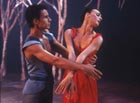
The Firebird 2003
Distributed by Bullfrog Films, PO Box 149, Oley, PA 19547; 800-543-FROG (3764)
Produced by Rhombus Media
Directed by Barbara Willis Sweete
VHS, color, 53 min.
Jr. High - Adult
Dance, Music, Canadian Studies
Date Entered: 07/07/2005
Reviewed by Joan Stahl, University of Maryland, College Park, MDThe first production of The Firebird (L’Oiseau de Feu), to the evocative score by Igor Stravinsky, was choreographed by Michel Fokine in 1910 and performed in Paris by Serge Diaghilev’s Ballets Russe. For the libretto, Fokine drew from Russian fairy tales. A heroic Prince Ivan goes out hunting in an enchanted forest, ruled by the evil Katschei. The Prince meets up with and captures the beguiling Firebird, who, in exchange for her freedom, gives the Prince a magic feather to summon her if he should be in danger. The Prince then encounters princesses who live in captivity under the Katschei and becomes enamored with the most beautiful among them, Princess Vasileva. When the Prince attempts to flee with the beautiful princess, Kastschei and the monstrous creatures in his kingdom descend upon the couple. The Firebird comes in to save the day. She casts a spell that destroys the evil kingdom and frees those who had been held captive. The couple is crowned as rulers over the kingdom and are wed amidst much pageantry.
The captivating story and score have inspired many choreographers to create their own vision of the dance. George Balanchine, Jon Neumeier, Maurice Béjart, and Glenn Tetley have all choreographed this story to this music, but have differed significantly in their interpretation. They have each chosen to emphasize or de-emphasize elements in the original ballet. James Kudelka, a Canadian dancer and choreographer, has followed suite and mounted his version. This film is an adaptation of Kudelka’s Firebird, which was first performed by the National Ballet of Canada in 2000; the film is a somewhat leaner, more focused presentation than the stage production, which was set in an imaginary South American locale. The sets and costumes here are less lavish than in many other productions and they evoke an imaginary time and place without suggestion of Russian culture. The special effects that are available through the magic of film are used to enhance the viewer’s sense of wonder; for example, the Firebird seems to emerge from a ball of fire and she traverses the stage / screen by flying. The principals, dancers from the National Ballet of Canada, include Greta Hodgkinson as the Firebird, Aleksandar Antonijevic as Prince Ivan, Rebekah Rimsay as Princess Vasileva, and Rex Harrington as Kastschei. The quality of the dancing is high, yet the ballet disappoints because while pleasing, Kudelka’s choreography is not revelatory. The movement is oddly lacking in its ability to advance the story and convey emotion, both of which are so expertly done by the musical score, here performed by the Kirov Orchestra. “Stylized” is a descriptor that feels appropriate, because the production lacks some traditional ingredients, such as elaborately costumed creatures and a Firebird, whose movement and attire suggest an exotic bird.
Although Kudelka’s Firebird is unlikely to be the production to which other Firebirds are compared, this film is certainly worthy of inclusion in school, public, and academic libraries that have an audience for dance. It is a high quality film in terms of its audio and video and the content will appeal to a large user group, ranging in age from teenager to mature adult.